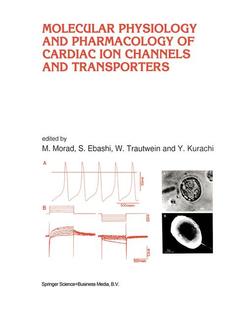Description
Molecular Physiology and Pharmacology of Cardiac Ion Channels and Transporters, Softcover reprint of the original 1st ed. 1996
Developments in Cardiovascular Medicine Series, Vol. 182
Coordinators: Morad M., Ebashi S., Trautwein W., Kurachi Yoshihisa
Language: English
Subjects for Molecular Physiology and Pharmacology of Cardiac Ion...:
Keywords
biology; cardiovascular; electrophysiology; heart; pathophysiology; physiology; research
Publication date: 10-2012
602 p. · 19.5x26 cm · Paperback
602 p. · 19.5x26 cm · Paperback
Description
/li>Contents
/li>
Knowledge of cardiac ion channels and transporters has advanced remarkably in the last two decades with the development of patch-clamp and molecular biological techniques. This textbook offers a comprehensive overview of structures and functions of ion channels and transporters in the heart. Readers are first introduced to the molecular biology and electrophysiology of all the important ion channels. After discussing their developmental changes, the pharmacology and pathophysiology of clinically-relevant ion channels are reviewed. Molecular aspects of the cardiac excitation-contraction coupling and intracellular Ca2+ regulation by ion transporters are also described. The book will be useful to electrophysiologists, cardiac physiologists and pharmacologists, and molecular biologists interested in ion channels at all levels. For research specialists, the book will provide a perspective of the field. The book can be used as a reference source for working scientists in the fields of ion channels, biophysics, cardiac electrophysiology, and pharmacology. It is aimed at graduate and medical students, designed for use as a textbook for graduate and medical courses.
Preface. Thoughts of my Friend, Hiroshi Irisawa; S. Ebashi. Dr Hiroshi Irisawa during his Youth and Physiology; I. Seyama. Part One: Section I: Channels and Channel Proteins. 1. Introduction. 2. A Pacemaker Channel. 3. The Cardiac N+ Channel. 4. The L-Type Cardiac Ca2+ Channel. 5. The Cardiac K+ Channels. 6. Cardiac Cl- Channels. 7. Cardiac Ion Channels Not Gated by Voltage. Section II: Ion Channels in Cardiovascular Development. Section III: Pharmacology of Ion Channels. Section IV: Ion Channels and Cardiac Pathology. Part Two: Section One: Molecular Aspects of Ca2+ Release. Section II: Molecular Steps in Cardiac Relaxation. 2. Molecular Biology and Physiology of Na+-Ca2+ Exchange. 3. Contraction-Relaxation Regulation. Section III: Regulation of Celluar Ca2+ by Other Transporters. Index.
© 2024 LAVOISIER S.A.S.
These books may interest you

Ion ChannelsVolume 1 52.74 €



